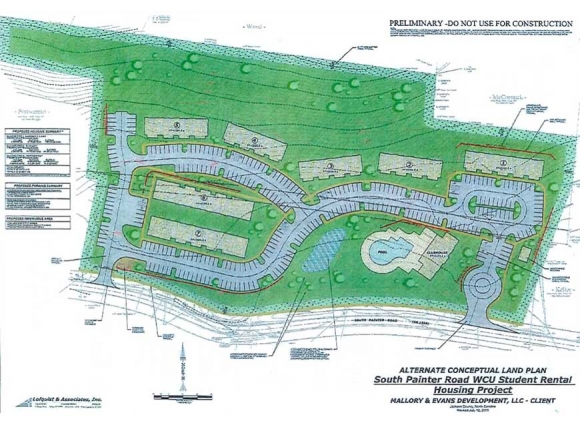Jackson County settles with student housing developer

Plans for a proposed housing development on South Painter Road in Cullowhee will proceed following the Jackson County Commissioners’ decision to accept a settlement agreement with Atlanta-based Mallory and Evans Development LLC.
Mallory and Evans brought its lawsuit against the county in August 2017 following a June 2017 Cullowhee Community Planning Council meeting in which members denied the developer’s application for a special-use permit to build a 388-bed housing complex. Court documents claimed that the decision was “the result of errors in law” and was “unsupported by substantial material and competent evidence, and is otherwise arbitrary and capricious.”
Rather than going to court on the matter, the parties opted to settle. Under the settlement agreement, Mallory and Evans will still get to build its development, but with significant changes to the original plan. The county spent about $15,000 on legal fees and costs related to the lawsuit.
Instead of building 97 units containing 388 bedrooms, the developer will construct 62 units containing 248 bedrooms. The number of parking spaces will likewise be reduced from 418 to 285, and the retaining wall to be built at the rear of the property will be 7 feet tall compared to the original 20 feet. A sidewalk will be built along South Painter Road continuing as far as the sidewalk segment the N.C. Department of Transportation is proposing for its Monteith Gap Road improvement project.
“I’m happy with it,” said Scott Baker, chairman of the Cullowhee Council. “I think it was a good compromise.”
“We worked closely with the local leaders on a plan that everyone involved could get behind and support,” said Brantley Basinger, principal for Mallory and Evans. “I believe we accomplished this together and have built stronger relationships through this process. We view this agreement as a win-win for Cullowhee, Western Carolina University and Mallory and Evans.”
Related Items
The developer hopes to break ground in late spring for an August 2020 opening.
The Cullowhee Council voted unanimously April 1 to recommend that the county accept the agreement. Following a closed session April 2, commissioners voted unanimously on three items related to the development. They approved the settlement agreement, accepted a $10,000 offer from Mallory and Evans for a sewer and stormwater easement and agreed to sell Mallory and Evans a 0.19-acre property adjoining the development for $25,000. That sale is now in the midst of the upset bid process. If nobody offers a better price before April 15, the sale will go through.
“They definitely reduced the number and the traffic flow count, and with it being gated I think that will help to alleviate a lot of extra vehicles going out that are not entitled to,” said Commissioner Mickey Luker. “I think with the unanimous approval from the Cullowhee committee, it pretty much put us in a thought to say, OK, we need to agree with those people we put on that board and move forward with it.”
This will not be the last time that Mallory and Evans will come before a county board, however. The developer will have to present the Jackson County Planning Board with a modified plan for approval, likely in May.
Mallory and Evans brought its original proposal before the Cullowhee Community Planning Council in June 2017, hoping to build the complex on an 11.6-acre piece of property along South Painter Road across from the Cullowhee Community Garden.
However, council members were concerned about the plan, especially in light of the 2016 death of pedestrian Daniel Brown on nearby Ledbetter Road, a hit-and-run involving a Western Carolina University student. The incident highlighted the danger of rapid, high-density development in an area whose narrow, winding roadways were not built to accommodate it.
Council members were afraid that the development would only exacerbate that situation, especially since the lack of sidewalks in the area meant that students would either have to drive to school or walk and bike in the already overtasked roadways. They were also concerned that the plan didn’t call for enough parking and that students would end up parking along the road and in people’s yards.
Evidence presented by the developer and its experts in traffic and engineering, meanwhile, told a different story. A study from Waynesville-based J.M. Teague Engineering concluded that the development would not negatively impact the roads. Basinger asserted that students would not be parking on the road.
In order to allow the development to move forward, council members had to vote yes on each of six standards, with votes based on evidence presented. The council did not return a majority yes vote on two of the standards — one dealing with the development’s compatibility with natural and topographic features, and another dealing with whether the development would cause traffic hazard or congestions.
With the reduction in the development’s size and upcoming improvements to Ledbetter and Monteith Gap Roads — Baker said the DOT is planning a project there to improve pedestrian and bicycle safety — he’s feeling much better about the traffic safety aspect.









